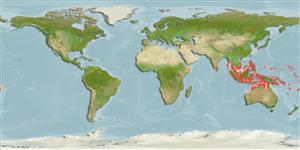Common names from other countries
>
Clupeiformes (Herrings) >
Dorosomatidae (Gizzard shads and sardinellas)
Etymology: Amblygaster: Greek, amblys = darkness + Greek, gaster = stomach (Ref. 45335).
Eponymy: Dr Pieter Bleeker (1819–1878) was an ichthyologist and army surgeon commissioned (1841) by the Dutch East India Company. [...] (Ref. 128868), visit book page.
More on author: Bleeker.
Environment: milieu / climate zone / εύρος βάθους / distribution range
Οικολογία
Θαλασσινό(ά) Υφαλόφιλο(α); εύρος βάθους 0 - 50 m (Ref. 188). Tropical; 17°N - 19°S, 75°E - 179°W (Ref. 188)
Indo-West Pacific: southern coasts of India, perhaps Bay of Bengal, and Indonesia eastward to Fiji. Reported from New Caledonia (Ref. 9070) and Tonga (Ref. 53797).
Μέγεθος / Βάρος / Age
Γεννητική Ωρίμανση: Lm ? range ? - ? cm
Max length : 27.6 cm TL αρσενικό/απροσδιόριστο; (Ref. 126292); common length : 15.0 cm SL αρσενικό/απροσδιόριστο; (Ref. 188); μεγ. δημοσιευμένο βάρος: 247.00 g (Ref. 126292)
Ραχιαίες άκανθες (συνολικά) : 0; Μαλακές ραχιαίες ακτίνες (συνολικά) : 13 - 21; Εδρικές άκανθες: 0; Μαλακές εδρικές ακτίνες: 12 - 23. Body moderately deep, belly rather rounded, scutes not prominent. Distinguished from A. sirm by the absence of spots along the flank (gold in life, black on preservation) and fewer lower gill rakers. Closely resembles A. leiogaster, which has more lower gill rakers. Round-bodied Sardinella species have i 8 pelvic fin rays and more than 100 lower gill rakers.
Body shape (shape guide): fusiform / normal; Cross section: compressed.
Forms schools in coastal waters. Feeds on copepods, Mysis and other elements in the zooplankton. Used as bait in the tuna fishery.
Life cycle and mating behavior
Γεννητική Ωρίμανση | Αναπαραγωγή | Γεννοβολία | Αβγά | Γονιμότητα | Προνύμφες
Spawn in school (Ref. 205).
Whitehead, P.J.P., 1985. FAO Species Catalogue. Vol. 7. Clupeoid fishes of the world (suborder Clupeoidei). An annotated and illustrated catalogue of the herrings, sardines, pilchards, sprats, shads, anchovies and wolf-herrings. FAO Fish. Synop. 125(7/1):1-303. Rome: FAO. (Ref. 188)
IUCN Red List Status (Ref. 130435: Version 2025-1)
Threat to humans
Harmless
Human uses
αλιεία: Εμπορικό(ά); δόλωμα: usually
Εργαλεία
Special reports
Download XML
Διαδικτυακές πηγές
Estimates based on models
Preferred temperature (Αναφ.
123201): 27.2 - 29.1, mean 28.5 °C (based on 988 cells).
Phylogenetic diversity index (Αναφ.
82804): PD
50 = 0.5625 [Uniqueness, from 0.5 = low to 2.0 = high].
Bayesian length-weight: a=0.00813 (0.00458 - 0.01442), b=3.07 (2.92 - 3.22), in cm total length, based on LWR estimates for this species & (Sub)family-body (Ref.
93245).
Τροφικό Επίπεδο (Αναφ.
69278): 3.1 ±0.28 se; based on food items.
Ελαστικότητα (Αναφ.
120179): Υψηλό, ελάχιστος χρόνος για διπλασιασμό πληθυσμού < 15 μήνες (Assuming Fec > 10,000).
Fishing Vulnerability (Ref.
59153): Low vulnerability (18 of 100).
🛈
Nutrients (Ref.
124155): Calcium = 95.5 [30.8, 395.3] mg/100g; Iron = 1.53 [0.53, 3.60] mg/100g; Protein = 20.2 [17.5, 22.6] %; Omega3 = 0.259 [0.118, 0.565] g/100g; Selenium = 51.1 [16.6, 168.4] μg/100g; VitaminA = 79.2 [16.6, 367.3] μg/100g; Zinc = 1.42 [0.70, 2.70] mg/100g (wet weight);
